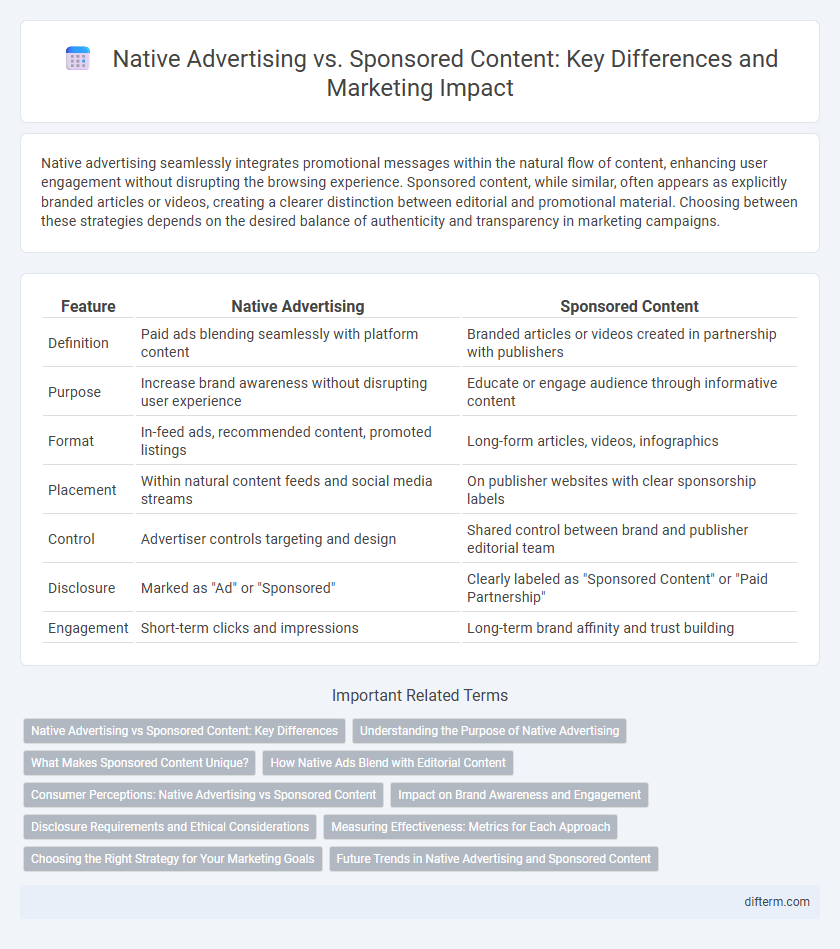Native advertising seamlessly integrates promotional messages within the natural flow of content, enhancing user engagement without disrupting the browsing experience. Sponsored content, while similar, often appears as explicitly branded articles or videos, creating a clearer distinction between editorial and promotional material. Choosing between these strategies depends on the desired balance of authenticity and transparency in marketing campaigns.
Table of Comparison
| Feature | Native Advertising | Sponsored Content |
|---|---|---|
| Definition | Paid ads blending seamlessly with platform content | Branded articles or videos created in partnership with publishers |
| Purpose | Increase brand awareness without disrupting user experience | Educate or engage audience through informative content |
| Format | In-feed ads, recommended content, promoted listings | Long-form articles, videos, infographics |
| Placement | Within natural content feeds and social media streams | On publisher websites with clear sponsorship labels |
| Control | Advertiser controls targeting and design | Shared control between brand and publisher editorial team |
| Disclosure | Marked as "Ad" or "Sponsored" | Clearly labeled as "Sponsored Content" or "Paid Partnership" |
| Engagement | Short-term clicks and impressions | Long-term brand affinity and trust building |
Native Advertising vs Sponsored Content: Key Differences
Native advertising seamlessly integrates promotional content within the platform's natural environment, enhancing user experience by matching the format and style of the surrounding content. Sponsored content, while also promotional, typically appears as distinct articles, videos, or posts created to provide value and brand exposure without necessarily mimicking the platform's editorial style. Native advertising emphasizes subtlety and user engagement, whereas sponsored content prioritizes brand storytelling and explicit sponsorship disclosure.
Understanding the Purpose of Native Advertising
Native advertising seamlessly integrates promotional messages within the platform's natural content flow, enhancing user engagement by matching the form and function of the surrounding media. Its primary purpose is to provide value-driven, relevant content that builds brand awareness without disrupting the user experience. This strategic approach contrasts with sponsored content, which often explicitly promotes a brand while maintaining editorial separation.
What Makes Sponsored Content Unique?
Sponsored content stands out by seamlessly integrating brand messages within editorial-style articles, offering value and relevance without overt sales pitches. Its unique approach fosters trust and engagement by aligning with the audience's interests and platform tone. Unlike native ads, sponsored content often provides deeper storytelling and informative experiences that enhance brand credibility.
How Native Ads Blend with Editorial Content
Native advertising seamlessly integrates with editorial content by matching the style, tone, and format of the platform it appears on, creating a non-disruptive user experience that enhances engagement. Unlike sponsored content, which is explicitly labeled and often presented as a separate article or segment, native ads are designed to look and feel like natural parts of the content stream, increasing their effectiveness and reducing ad fatigue. This blending technique leverages contextual relevance and subtle branding to drive higher click-through rates and better audience retention.
Consumer Perceptions: Native Advertising vs Sponsored Content
Consumer perceptions of native advertising often emphasize its seamless integration within content, leading to higher engagement due to reduced intrusiveness and enhanced relevance. Sponsored content is frequently viewed with more skepticism as it explicitly signals paid promotion, which can affect trust and perceived authenticity. Effective marketing strategies leverage transparency and alignment with audience interests to balance engagement and credibility in both native advertising and sponsored content.
Impact on Brand Awareness and Engagement
Native advertising seamlessly integrates promotional messages within relevant content, enhancing brand awareness by appearing less intrusive and fostering higher user engagement rates. Sponsored content delivers tailored narratives that resonate with target audiences, driving deeper emotional connections and increasing time spent on branded materials. Both strategies effectively boost brand visibility, but native advertising often yields quicker, broader reach while sponsored content fosters sustained engagement and loyalty.
Disclosure Requirements and Ethical Considerations
Native advertising and sponsored content require clear disclosure to maintain transparency and comply with regulatory guidelines such as the FTC's truth-in-advertising rules. Ethical considerations emphasize the importance of distinguishing paid promotions from editorial content to preserve consumer trust and avoid deceptive marketing practices. Marketers must label native ads and sponsored articles clearly using terms like "Sponsored" or "Paid Promotion" to ensure audiences can easily identify the commercial nature of the message.
Measuring Effectiveness: Metrics for Each Approach
Measuring effectiveness in native advertising primarily relies on engagement metrics such as click-through rates (CTR), time spent on content, and conversion rates, highlighting user interaction with seamlessly integrated ads. Sponsored content effectiveness is often gauged through brand lift studies, social shares, and sentiment analysis to assess audience perception and brand affinity. Both approaches benefit from tracking ROI and attribution models to link marketing efforts directly to sales performance.
Choosing the Right Strategy for Your Marketing Goals
Choosing between native advertising and sponsored content depends on your marketing goals and target audience engagement preferences. Native advertising integrates seamlessly into platform content, enhancing brand visibility without disrupting user experience, while sponsored content offers in-depth storytelling and expertise to build trust and authority. Aligning strategy with objectives like brand awareness, lead generation, or customer loyalty ensures optimal ROI and campaign effectiveness.
Future Trends in Native Advertising and Sponsored Content
Future trends in native advertising and sponsored content emphasize increased integration of AI-driven personalization to deliver highly targeted and relevant messaging across diverse digital platforms. Enhanced transparency and compliance with privacy regulations will drive the adoption of blockchain technology for secure and verifiable ad placements. Brands are expected to leverage immersive formats like augmented reality (AR) and interactive videos to create more engaging and authentic consumer experiences.
Native Advertising vs Sponsored Content Infographic

 difterm.com
difterm.com